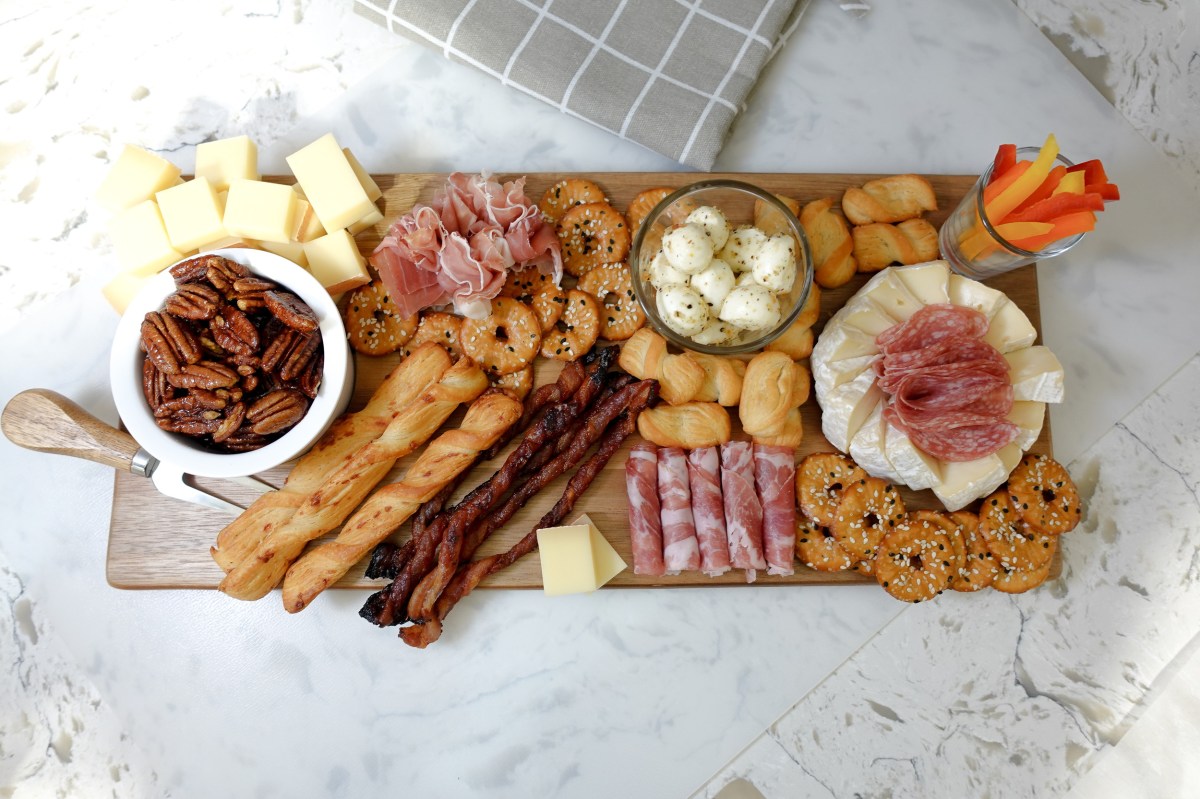Imagine a vibrant tapestry of colors and textures, a charcuterie board bursting with flavor, yet meticulously crafted to be completely safe for those with allergies. This isn’t a dream; it’s the delicious reality of allergy-friendly, soy-free charcuterie boards. We’ll guide you through selecting the perfect ingredients, crafting delectable spreads, and arranging a visually stunning board that’s both safe and sensational. Prepare to elevate your entertaining game while accommodating dietary restrictions with grace and style.
This comprehensive guide dives deep into creating beautiful and safe charcuterie boards. We’ll explore ingredient selection, offering soy-free alternatives for common allergens like nuts and dairy. You’ll discover three unique spread recipes, each detailed with step-by-step instructions and nutritional information. We’ll also cover safe handling practices to prevent cross-contamination, ensuring your board is not only delicious but also entirely worry-free for your guests.
Ingredient Selection & Substitutions
Creating an allergy-friendly and soy-free charcuterie board requires careful consideration of ingredients. This involves selecting items naturally free from common allergens and finding suitable replacements for those that typically contain soy or other allergens. The goal is to provide a delicious and inclusive spread for everyone to enjoy.
Suitable Cheeses and Dairy-Free Alternatives
A variety of cheeses can form the foundation of your charcuterie board. Hard cheeses like cheddar, parmesan, and Gruyère are generally well-tolerated, but always check labels for potential allergens. For those avoiding dairy, there are many delicious plant-based options available. Consider cashew-based cheeses, which often mimic the creamy texture of traditional cheeses, or coconut-based cheeses, which offer a unique, firm texture. Many brands offer dairy-free alternatives that are soy-free as well, making them perfect for this specific need. Remember to always double-check labels to confirm the absence of soy and other allergens.
Cured Meats Free of Soy and Other Allergens
Selecting cured meats requires careful label reading. Many processed meats contain soy as a binder or flavor enhancer. Look for meats clearly labeled as “soy-free” and check for other potential allergens such as gluten or nuts. Consider opting for simpler cured meats like prosciutto, salami (ensure soy-free), or bresaola. These are often less processed and more likely to be free of hidden allergens. When in doubt, contact the manufacturer directly to confirm the ingredients.
Fruits and Vegetables: A Colorful and Allergy-Safe Addition
Fresh fruits and vegetables add vibrant color and texture to your charcuterie board. Consider a variety of options to cater to different tastes and preferences. Think juicy grapes, crisp apple slices, sweet berries, crunchy carrots, and colorful bell peppers. These ingredients are naturally free from the common allergens we’re avoiding, making them a safe and delicious addition to your spread.
Crackers and Breads: Ensuring Allergy-Friendly Options
Many commercially produced crackers contain soy or wheat. To ensure an allergy-safe board, choose crackers explicitly labeled as soy-free and gluten-free. Alternatively, consider making your own crackers using simple, allergy-friendly ingredients like almond flour or rice flour. You can also include gluten-free bread options, but always carefully check labels to ensure they are also soy-free.
Spreads and Dips: Allergy-Conscious Choices
Spreads and dips add another layer of flavor and texture to your charcuterie board. However, many commercially available options contain soy or other allergens. For a safe and delicious alternative, consider homemade options. A simple hummus made from chickpeas, tahini (ensure it’s soy-free), lemon juice, and garlic is a crowd-pleaser. Alternatively, a simple olive tapenade or a creamy avocado dip are also excellent choices. Always check labels on store-bought options, as ingredients can vary.
Ingredient Details
| Ingredient | Allergy Information | Soy-Free Alternative | Notes |
|---|---|---|---|
| Soy Sauce | Soy | Coconut aminos, tamari (check label for soy), Bragg’s Liquid Aminos | Use sparingly; flavors can be intense. |
| Processed Cheese | Dairy, Soy (sometimes) | Dairy-free cheese (cashew, coconut), hard cheeses (check labels) | Read labels carefully for hidden allergens. |
| Salami | Soy (sometimes), Gluten (sometimes) | Soy-free and gluten-free salami (check labels carefully) | Always check labels for specific allergen information. |
| Crackers | Wheat, Soy (sometimes) | Gluten-free and soy-free crackers (check labels) | Many brands offer allergy-friendly options. |
| Mayonnaise | Soy (sometimes), Eggs | Avocado mayo, homemade mayo (using soy-free oil) | Ensure all ingredients are soy-free and allergen-free. |
Dietary Considerations & Allergen Cross-Contamination

Creating an allergy-friendly charcuterie board requires meticulous attention to detail, especially concerning cross-contamination and the presence of hidden allergens. Even with careful ingredient selection, improper handling can easily introduce unwanted allergens, rendering the board unsafe for those with sensitivities. Understanding and implementing preventative measures is paramount to ensure a safe and enjoyable experience for all.
Cross-contamination is a significant risk when preparing food for individuals with allergies. This occurs when allergens transfer from contaminated surfaces, utensils, or ingredients to allergy-free foods. The potential for cross-contamination increases exponentially when handling multiple ingredients, especially those containing common allergens. The following sections detail strategies to mitigate these risks and create a truly allergy-safe charcuterie board.
Common Allergens and Avoidance Strategies
Beyond soy, many other ingredients commonly found on charcuterie boards pose significant allergy risks. These include nuts (peanuts, tree nuts), dairy, eggs, wheat, shellfish, fish, and sesame seeds. Avoiding these requires diligent ingredient checking and careful preparation techniques. For instance, using separate cutting boards and utensils for each ingredient group prevents cross-contamination. Thoroughly cleaning all surfaces and equipment between uses is crucial. Pre-packaged items should be checked for allergen declarations on the label. Reading labels carefully is not enough; it is important to understand the labeling requirements in your area, as they can vary from place to place.
Preventing Allergen Cross-Contamination
Preventing cross-contamination involves a multi-pronged approach. First, designate separate preparation areas and utensils for allergen-containing and allergen-free ingredients. Imagine a kitchen divided into two distinct zones: one solely for allergy-friendly items, the other for potentially allergenic ingredients. This spatial separation minimizes the chance of accidental contact. Second, utilize color-coded cutting boards and utensils to visually distinguish between ingredients and prevent accidental mixing. For example, a green cutting board might be used exclusively for vegetables, while a red one is reserved for nuts. Third, thorough handwashing before and after handling each ingredient group is essential to prevent allergen transfer.
Clear Labeling and Serving
Clearly labeling each item on the charcuterie board is critical for preventing accidental allergen consumption. Use small, clear labels with bold text indicating the ingredient names and any potential allergens. For example, a label might read: “Soy-Free Prosciutto,” or “Dairy-Free Cheese.” If serving multiple boards, clearly label each board with its allergen information. For example, “Allergen-Free Board” or “Nut-Free Board”. Consider providing separate serving utensils for each item to further minimize cross-contamination. Visual cues, such as different-colored serving spoons for different food groups, can also help guests avoid accidental allergen exposure.
Allergen Prevention Strategies
| Allergen | Prevention Strategies |
|---|---|
| Nuts (peanuts, tree nuts) | Use nut-free alternatives; dedicate separate cutting boards and utensils; carefully check labels for cross-contamination warnings; clearly label nut-free items. |
| Dairy | Use dairy-free alternatives (e.g., soy-free cheese alternatives); ensure separate utensils and preparation surfaces are used. |
| Eggs | Choose egg-free products; check ingredient lists carefully; ensure separate utensils and preparation surfaces are used. |
| Wheat | Use gluten-free crackers and bread; ensure separate utensils and preparation surfaces are used; check labels carefully for gluten-free certification. |
| Shellfish | Avoid using any shellfish products; ensure that preparation surfaces and utensils are thoroughly cleaned if used for shellfish previously. |
| Fish | Avoid using any fish products; ensure that preparation surfaces and utensils are thoroughly cleaned if used for fish previously. |
| Sesame | Check labels carefully for sesame; use sesame-free alternatives; ensure separate utensils and preparation surfaces are used. |
Step-by-Step Guide to Creating the Board
Crafting an allergy-friendly, soy-free charcuterie board is a delightful culinary adventure that allows you to showcase a vibrant array of flavors and textures while prioritizing safety and inclusivity. This step-by-step guide will walk you through the process, from careful ingredient selection to the artful arrangement of your delectable spread.
Board Selection and Preparation
Choosing the right serving board is crucial for both functionality and aesthetic appeal. A large, sturdy wooden board, a slate platter, or even a large ceramic plate can serve as an excellent base. Ensure your chosen surface is clean and free from any potential allergens. Before arranging your items, consider lining the board with parchment paper; this simplifies cleanup and prevents staining. A lightly dampened kitchen towel placed under the board can also help to prevent it from slipping during assembly.
Ingredient Preparation
Carefully wash and prepare all ingredients. Cut cheeses into bite-sized pieces or wedges, ensuring variety in size and shape. Arrange cured meats such as prosciutto or turkey (carefully checking labels for soy and allergen cross-contamination) in overlapping swirls. Wash and trim fresh fruits and vegetables, such as grapes, berries, sliced bell peppers, and cucumber, and arrange them strategically. Consider adding nuts (always check for allergen cross-contamination and verify they are soy-free) or seeds for added texture and flavor, ensuring they are clearly separated from other ingredients.
Arranging the Board: A Visual Feast
The arrangement of your charcuterie board is key to its visual appeal. Begin by placing the larger items – cheeses and cured meats – as anchors. Strategically position them around the board, leaving spaces for smaller items. Next, fill in the gaps with smaller components like olives, nuts, fruits, and vegetables. Consider color contrast and texture variation. A visually appealing board incorporates a mix of heights and shapes. For instance, a tall stack of crackers next to a low arrangement of berries creates a dynamic effect. Think of it as a landscape, with different “hills” and “valleys” of food. Ensure that all allergen-containing items are clearly labeled or separated from others.
Storage and Serving
For optimal freshness, it is recommended to assemble the charcuterie board just before serving. However, if advance preparation is necessary, store individual components separately, covered, in the refrigerator. Assemble the board shortly before guests arrive. Use separate serving utensils for each item to prevent cross-contamination. Consider providing small individual plates or napkins for guests to avoid direct contact with the board itself. Cover any remaining portions immediately after serving to maintain freshness and prevent contamination.
Creating an allergy-friendly, soy-free charcuterie board is more than just avoiding certain ingredients; it’s about crafting a thoughtful and inclusive culinary experience. By following the steps Artikeld, you can confidently create a visually stunning and delicious board that caters to various dietary needs. Remember, the key is careful planning, precise execution, and a touch of creative flair. So, gather your ingredients, unleash your inner artist, and prepare to impress your guests with a charcuterie board that’s both beautiful and safe.
Clarifying Questions
Can I prepare the board ahead of time?
Yes, many components can be prepped in advance. Prepare spreads and chop vegetables a day or two prior. Store them separately and assemble the board just before serving to maintain freshness and prevent cross-contamination.
What if I don’t have all the suggested ingredients?
Don’t worry! Adapt the recipes to your liking. The key is to focus on the allergy-free aspect. Substitute similar ingredients while ensuring they are soy-free and meet your guests’ dietary needs. Creativity is encouraged!
How do I store leftovers?
Store leftover spreads and ingredients separately in airtight containers in the refrigerator. Do not reuse the same serving board or utensils without thoroughly cleaning them.
Are there any specific types of serving boards to avoid?
Avoid wooden boards that are difficult to thoroughly clean and sanitize. Opt for materials that are easy to clean, like glass, ceramic, or plastic.


